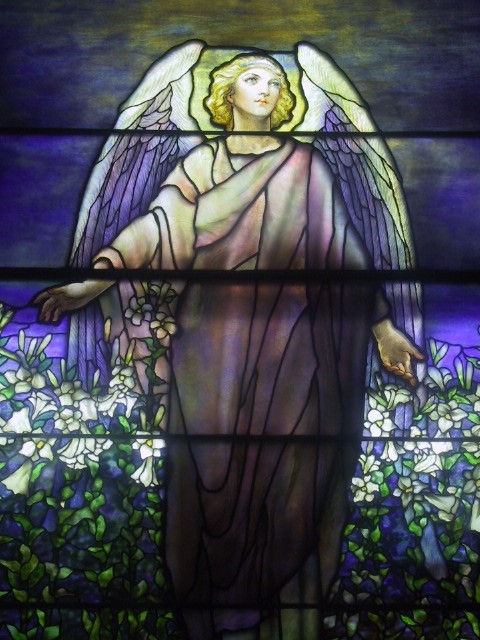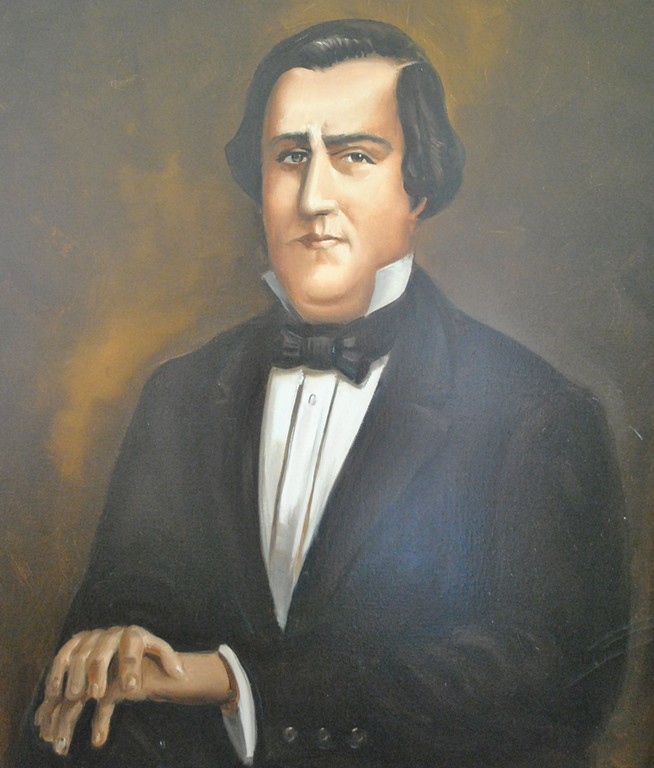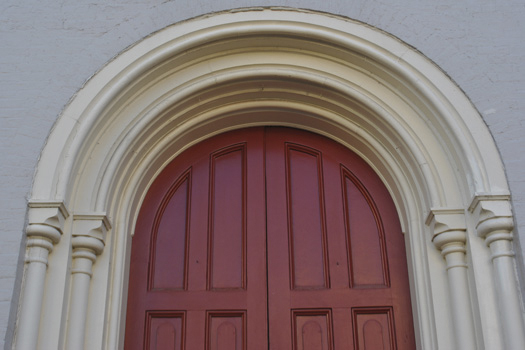
This was a popular subject – symbol of purity. Famous Angel of Resurrection window in Indianpolis commissioned by Benjamin Harrison’s 2nd wife.
Inscription: “Whosoever Liveth and Believeth In Me, Shall Never Die”
Dedication: In memory of Alexander Keene Phillips, 1805-1892 and Annie Douglas Phillips, 1835-1913
Given by children of Alexander Keene Phillips in memory of parents. Window was dedicated July 6, 1914
Maker/Date: Tiffany Studios, New York, 1914
Description – The inscription is from John 11:26. Jesus is speaking with Martha in Bethany, consoling her and is trying to connect the resurrection with the present.
John 11:20-30 New Revised Standard Version (NRSV). This chapter deals with the death of Lazarus – actually pre Holy Week.
20 When Martha heard that Jesus was coming, she went and met him, while Mary stayed at home. 21 Martha said to Jesus, “Lord, if you had been here, my brother would not have died. 22 But even now I know that God will give you whatever you ask of him.” 23 Jesus said to her, “Your brother will rise again.” 24 Martha said to him, “I know that he will rise again in the resurrection on the last day.” 25 Jesus said to her, “I am the resurrection and the life.[a] Those who believe in me, even though they die, will live, 26 and everyone who lives and believes in me will never die. Do you believe this?” 27 She said to him, “Yes, Lord, I believe that you are the Messiah,[b] the Son of God, the one coming into the world.”
Techniques –
The angel announced Jesus’ resurrection in the Gospels. In this window, the angel is sitting in field of snow white lilies, clad in robes of pink.
Pink – “young beloved” . White “purity and righteousness”
Gospel of John actually has two angels in white waiting inside the tomb when Mary entered (but not there earlier when Peter and John looked inside. One angel at food of tomb and other at end
The windows show Tiffany’s work in drapery glass for the angel’s robes that are close to fabric folds. Tiffany’s use of glass plays well with the sun which strikes the window in the morning hours. It accentuates the paint and enamel to the face and hands.
-Also use of confetti glass for flowers
-Jewels for the flowers
Symbols – The yellow-streaked, sun-dappled clouds are a dawn-sky, a common metaphor for rebirth

Background – Alexander K. Phillips became the first president of the National Bank of Fredericksburg in 1865 and had been previously involved in many businesses, including grain and mercantile. He owned the Commission House in Fredericksburg which was built for him in 1875 and still stands. He sat in pew 92
His banking career began in 1840 when at the age of 35 he was elected to the Board of Directors of the Farmers Bank of Fredericksburg, a position he retained for 25 years.
The son of Captain Samuel Phillips, a native of Dorchester, MD., Mr. Phillips was born in 1805. From early manhood he was associated with his father in the mercantile and grain business. But his activities were many and diverse. He was agent for the Baltimore-Fredericksburg Steamship line
Alexander Keene Phillips died in his 88th year in 1892, the oldest man in Fredericksburg.
He was chiefly a commission merchant in grain and other commodities a field he inherited from his father Samuel Phillips. (A commission merchant was a merchant shipping firm. It was primarily involved in the buying and selling of grain and coal.). Before the era of the railroad, Fredericksburg played a major role in shipping throughout the Americas. After Samuel Phillips died he used part of the estate to establish his own company A. K. Phillips and Co. Like many 19th century business men he branched out to become director or president of many businesses;
Director
- Farmers Bank, 1858,1860
- Virginia Bank, 1859
- Fredericksburg Insurance Co, 1854
- Railroad Co, 1854
5. Plank Road Co, 1854
President
- Old Dominion Mining company
- Fredericksburg Gordonsville Railroad
- Fredericksburg Canal Company
- Fredericksburg Gas company
In the 1855 he bought Mulberry Hill and 500 acres in Stafford. The home was a two story gothic revival with one of the few homes of the period with indoor plumbing. An indoor tank supplied water through silver faucets to marble basins. It became General Burnsides headquarters for the Battle of Fredericksburg. Later
Built in 1851 by John and Lucy Chinn, this was one of the most fashionable homes in the Fredericksburg region. Its high style befit its wartime owner, Phillips, a diverse entrepreneur who served on town council and owned a brew house, warehouse, three wharves, and a lumber yard in Fredericksburg. Phillips purchased “Mulberry Hill” in 1855 and lived both there and in his mother’s residence on Caroline Street in Fredericksburg. In 1860, Phillips, 56, lived with Anna Phillips, 28, his daughter, and his mother, Margaret, 82. The Phillips household owned twelve slaves.
Gutted by fire 2/14/1863. 227 union bodies there. One of dependencies a slave quarter survives
Owned 550 acres in Stafford, 300 improved
His home in Fredericksburg later became the 2nd Montgomery Slaughter home 401 Hanover 2 stories – 2 slave quarters near by. Age 54 in 1860
9 slaves in Fredericksburg. Mehchant RE Valujed $50,000 and personal $57,200
Only wife lived there.. No Children listed.
- Councilman 1852,1857
- Director of Farmers Bank 1858,1860
- Director of Va. Bank 1859
- Director Fred. Insurance Co 1854
- Director Railroad Co 1854
- Director Plank Road Co 1854
Partner – Samuel Phillips and Son – Commission Business
Phillips’ wealth like many of the local residents suffered declines in the Civil War years and was unable to purchase stock himself in the new bank. His taxable personal property was reduced from $23,310 in 1860 and $2,460 a decade later, most due to a decline in bonds. His real property also suffered a similar reversal.
His most lasting achievement was the establishment of the National Bank of Fredericksburg, an independent bank from 1865 until bought by Mercantile Bankshares in 1994. In 1865 at the end of the Civil War, the Fredericksburg economy had been wrecked by destruction and needed capital for recovery. Confederate bonds were worthless. Phillips convinced Maryland friends to invest in 905 of 1,000 shares to help charter the National Bank on Oct. 11, 1865. Phillips served as president for 6 years. One historian writes “National Bank of Fredericksburg owes its existence to Alexander Keene Phillips.”
Phillips properties included his mother’s home on Caroline Street and a warehouse property 100 Frederick Street known as the “Commission House”.
In 1876 A.K. Phillips and Co. built the present 7,000 square foot building as an office and warehouse for his import/export business. By that time Phillips was a coal and lumber merchant. Because of this use, the building is often referred to as the “Commission House.” It was converted into a modern home in 1985 by owners Tommy and Kim Mitchell. The interior brick walls and beams were sandblasted to bring them back to their original color
Obituary – “He inherited the established business of his father and with singular prudence, steadfastness and sagacity he added to the high reputation of the old house by a course of life marked by the highest business intelligence and the most unsullied integrity. It may be said without qualification that the name of Phillips was wherever known, the symbol of confidence and trust.”
